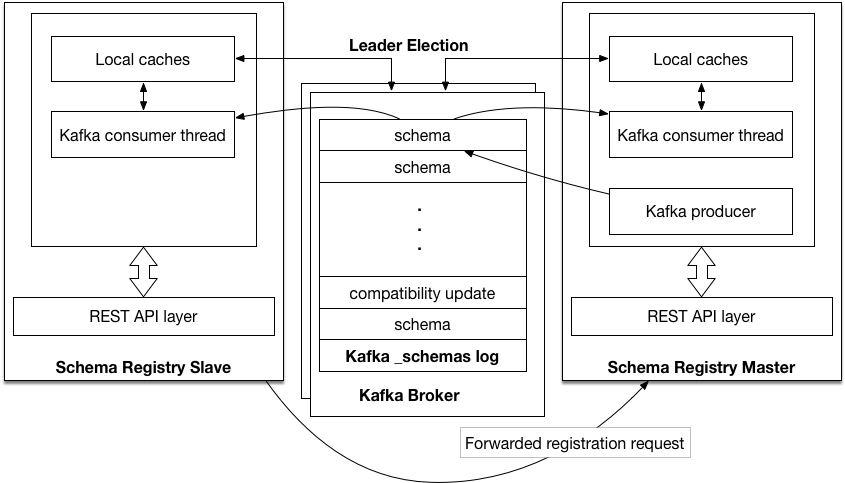Important
You are viewing documentation for an older version of Confluent Platform. For the latest, click here.
Schema Registry¶
Schema Registry provides a serving layer for your metadata. It provides a RESTful interface for storing and retrieving Avro schemas. It stores a versioned history of all schemas, provides multiple compatibility settings and allows evolution of schemas according to the configured compatibility settings and expanded Avro support. It provides serializers that plug into Kafka clients that handle schema storage and retrieval for Kafka messages that are sent in the Avro format.
Schema Registry is a distributed storage layer for Avro Schemas which uses Kafka as its underlying storage mechanism. Some key design decisions:
- Assigns globally unique ID to each registered schema. Allocated IDs are guaranteed to be monotonically increasing but not necessarily consecutive.
- Kafka provides the durable backend, and functions as a write-ahead changelog for the state of Schema Registry and the schemas it contains.
- Schema Registry is designed to be distributed, with single-master architecture, and ZooKeeper/Kafka coordinates master election (based on the configuration).
Tip
To see a working example of Schema Registry, check out Confluent Platform demo. The demo shows you how to deploy a Kafka streaming ETL, including Schema Registry, using KSQL for stream processing.
Schema ID Allocation¶
Schema ID allocation always happen in the master node and they ensure that the Schema IDs are monotonically increasing.
If you are using Kafka master election, the Schema ID is always based off the last ID that was
written to Kafka store. During a master re-election, batch allocation happens only after the new
master has caught up with all the records in the store <kafkastore.topic>.
If you are using ZooKeeper master election, /<schema.registry.zk.namespace>/schema_id_counter
path stores the upper bound on the current ID batch, and new batch allocation is triggered by both master election and exhaustion of the current batch. This batch allocation helps guard against potential zombie-master scenarios, (for example, if the previous master had a GC pause that lasted longer than the ZooKeeper timeout, triggering master reelection).
Kafka Backend¶
Kafka is used as Schema Registry storage backend. The special Kafka topic <kafkastore.topic> (default _schemas), with a single partition, is used as a highly available write ahead log. All schemas, subject/version and ID metadata, and compatibility settings are appended as messages to this log. A Schema Registry instance therefore both produces and consumes messages under the _schemas topic. It produces messages to the log when, for example, new schemas are registered under a subject, or when updates to compatibility settings are registered. Schema Registry consumes from the _schemas log in a background thread, and updates its local caches on consumption of each new _schemas message to reflect the newly added schema or compatibility setting. Updating local state from the Kafka log in this manner ensures durability, ordering, and easy recoverability.
Single Master Architecture¶
Schema Registry is designed to work as a distributed service using single master architecture. In this configuration, at most one Schema Registry instance is master at any given moment (ignoring pathological ‘zombie masters’). Only the master is capable of publishing writes to the underlying Kafka log, but all nodes are capable of directly serving read requests. Slave nodes serve registration requests indirectly by simply forwarding them to the current master, and returning the response supplied by the master. Prior to Schema Registry version 4.0, master election was always coordinated through ZooKeeper. Master election can now optionally happen via Kafka group protocol as well.
Note
Please make sure not to mix up the election modes amongst the nodes in same cluster. This will lead to multiple masters and issues with your operations.
Kafka Coordinator Master Election¶

Kafka based Schema Registry
Kafka based master election is chosen when <kafkastore.connection.url> is not configured and
has the Kafka bootstrap brokers <kafkastore.bootstrap.servers> specified. The kafka group
protocol, chooses one amongst the master eligible nodes master.eligibility=true as the master. Kafka-based master
election can be used in cases where ZooKeeper is not available, for example for hosted or cloud
Kafka environments, or if access to ZooKeeper has been locked down.
ZooKeeper Master Election¶

ZooKeeper based Schema Registry
ZooKeeper master election is chosen when ZooKeeper URL is specified in Schema Registry config
<kafkastore.connection.url>.
The current master is maintained as data in the ephemeral node on the /<schema.registry.zk.namespace>/schema_registry_master path in ZooKeeper. Schema Registry nodes listen to data change and deletion events on this path, and shutdown or failure of the master process triggers each node with master.eligibility=true to participate in a new round of election. Master election is a simple ‘first writer wins’ policy: the first node to successfully write its own data to /<schema.registry.zk.namespace>/schema_registry_master is the new master.
Schema Registry is also designed for multi-colo configuration. See Schema Registry Multi-DC Setup for more details.
